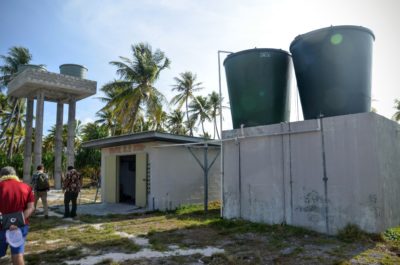Since President Trump announced last month his intention to pull the United States out of the Paris climate agreement, attention has been focused on the Green Climate Fund — a multilateral fund through which developed countries enable developing countries to finance climate-related projects. Established in 2010 and drawing heavily on U.S. leadership, the fund provides grants, loans, and equity financing for projects that seek to reduce emissions and promote climate-change adaptation, especially in the poorest and most vulnerable nations.
President Trump believes the Green Climate Fund (GCF) is not a good deal for America. During his speech withdrawing from the Paris agreement, he referred to the GCF as a “slush fund underwritten by American taxpayers” and made clear his intention to “terminate” any further U.S. contributions. The GCF has received over $10 billion in pledges from 43 countries, and follow-through on the president’s statement would mean the United States would only deliver the first $1 billion of its $3 billion pledge.
President Trump announcing his decision to withdraw from the Paris climate accord last month. REUTERS
A poll taken just after Trump’s announcement found that 57 percent of U.S. registered voters disagreed with his decision on Paris, while only 24 percent agreed. But public opinion is more divided about providing international climate finance. The same poll found that 48 percent do not support aid to help developing countries reduce their emissions, while only 32 percent do, and 20 percent are undecided.
Clearly, Americans are wary of providing money for emission-reduction initiatives overseas. So what is the case for using U.S. taxpayer dollars to support the Green Climate Fund?
The two of us are familiar with making that case. We represented the United States on the governing board of the GCF between 2013 and 2017. In that capacity, we worked abroad with leaders from other countries to design the GCF and make it operational. At home, part of our job was to provide budget justifications to Congress in support of the multilateral initiative. The reality is that investments in the GCF advance the strategic interests of the United States.
The starting point for understanding that is recognizing how climate change is a threat multiplier and risk magnifier. Scientific evidence already points to climate change increasing water stress, sea level rise, storm frequency and severity, threats to human health, food insecurity, and violent conflict. And it has become clear that as these impacts grow more severe, they will hit hardest in regions where people are poor and least able to adapt.
Bangladesh provides a case in point. A country of 160 million people, it is one of the most vulnerable to climate risks through cyclones, floods, and saltwater intrusion into agricultural land and drinking water. Several U.S. government agencies have studied the risks facing Bangladesh and issued alarms about the possibility of a major disaster involving flood-induced water shortages, epidemics, and violent conflict. A primary concern is the displacement of millions of Bangladeshis into areas of India that have insufficient resources to cope and where there is the potential for religious tensions.
President Trump should be boasting about savvy leverage on our investment rather than railing against bad deals.
Helping Bangladesh and other nations build resilience to climate change is not only compelling from moral and humanitarian perspectives. It also protects national borders and regional stability in one of the world’s most complex regions. And from the U.S. perspective, it is especially important because of our significant interests overseas and our role in shouldering a large share of the costs when international disasters occur.
This is where the GCF can help. Take one example. The GCF recently approved a project in Bangladesh to establish a national center for gathering, developing, and sharing knowledge about how to make infrastructure more resilient. The project targets three of the most vulnerable and poor coastal districts — Bhola, Barguna, and Satkhira. Initiatives there intended to grow in scale will demonstrate how improvements to drainage, flood protection, sanitation, water supply, and transportation can be made more resilient. The project will also expand and improve cyclone shelters, which in normal times will double as schools, educating over 18,000 children.
The total project cost is $80 million. But the GCF is not alone in providing the funding. The Bangladeshis themselves are putting in $25 million, along with $15 million from Germany, with the GCF covering the remaining $40 million. This is a good deal for American taxpayers, as the United States in only one of the 43 contributing countries to the GCF.
In addition, the claim that other nations are not paying their fair share is simply not true. The U.S economy is more than twice the size of the combined economies of the United Kingdom, Germany, and France. Yet, the pledges to the GCF of these three countries together exceeds that of the United States. Indeed, this is a case where President Trump should be boasting about savvy leverage on our investment rather than railing against bad deals.
Water tanks in the Marshall Islands, part of a Green Climate Fund project to build drought resilience. UNDP
To be sure, projects such as the one in Bangladesh cannot prevent cyclones or floods from happening in the first place. But they can help communities mitigate the damage, bounce back faster, and avoid more serious humanitarian and security disasters.
International finance must also focus on preventing the emissions that cause climate change. Even Trump has observed that emission reductions in the United States are not enough to mitigate climate change in a meaningful way — an implicit acknowledgement by the president that climate change is indeed happening. But because this is a global problem, emissions must be cut in other countries as well. Increases in future emissions will be greatest in developing countries, and that is where reductions will often be the most cost effective.
That’s because many less-developed countries have yet to build out their energy infrastructure. Rather than doing that by relying on outdated, inefficient, and highly polluting technologies, these nations have the opportunity to skip directly to the more efficient and cleaner technologies of today. We have already seen such “leapfrogging” with communications, as many countries skipped right over telephone poles and moved directly to cellular technology. The same can happen with bringing electricity to the more than 1 billion people in the world who currently lack it. But access to public and private finance is critical.
This is where the GCF can help. Take, for example, Kenya — a country of 46 million people where 80 percent live off the electricity grid and 35 million lack access to affordable and reliable electricity. The GCF recently invested $25 million to provide early-stage venture capital for off-grid solar technology focused initially in Kenya and Rwanda. This investment is managed by the New York-based Acumen Fund, which put in $5 million of its own money and expects to raise an additional $75 million from other investors.
This is not a case of international charity – what’s good for the Green Climate Fund is good for America.
The goal is to jumpstart 10-15 private-sector companies that will bring clean energy to areas where access to electricity is essential for development. If successful, tens of thousands of Kenyans and Rwandans will gain access to reliable energy; avoided emissions will number in the millions of tons; and U.S. investors will see a return on their investment. In places like the United States, we may take early-stage venture capital for granted, but in many developing countries such capital is often nonexistent.
The GCF is beginning to serve as a catalyst for these opportunities in countries where it is needed most. The multiplier effects are evident: the United States puts in 30 cents of each GCF dollar, the project sponsor puts some of its own skin in the game, and investors scale things up to potentially many times more. The results can be win-win-win: a return on investment; a reduction in global emissions; and all countries — including the United States — benefitting from avoiding further costs from climate change.
The GCF was designed as a multilateral financial institution focused on climate change mitigation and adaptation, along with an emphasis on leveraging the resources of the private sector. All these dimensions are essential for meeting the growing challenges of climate change. And given the complexity of coordinating the efforts of the various participating countries, the GCF has made tremendous progress in a relatively short period of time.
President Trump is simply wrong when he asserts that “nobody even knows where the money is going to. Nobody’s been able to say where is it going to.” We have briefly described here only two of the approved GCF projects. There are currently 41 others, worth $2.2 billion in GCF funding — from solar-powered irrigation in India to early-warning systems for Malawi — and many more are on the way. But keeping the momentum will depend on the United States continuing to provide leadership and meeting its commitments. This is not a case of international charity — what’s good for the GCF is good for America.
While Trump has the authority to initiate a withdrawal from the Paris agreement, the president must work with Congress when it comes to approving the budget. There is a long history of both Republican and Democratic support of climate finance dating back to President George H.W. Bush’s signing of the Rio Earth Summit climate agreement in 1992, which created the first multilateral financial mechanism for meeting environmental challenges. And it includes George W. Bush’s $2 billion fully-paid pledge to the Clean Technology Fund, a multilateral initiative to support modern energy technologies with the help of the private sector. Indeed, the United States has been an important leader and contributor to these efforts. We hope that Congress will exercise better judgment than the president and carry on this tradition by continuing to support the GCF.



